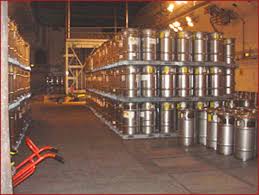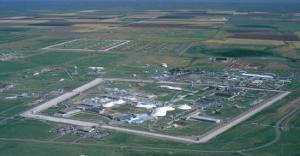New Report 'Unleashing Plutonium Proliferation in the U.S. Holds Risks,' Questions Plutonium Give-Away by U.S. DOE

SRS Watch is a non-profit public-interest group located in Columbia, South Carolina that monitors policies and programs of the U.S. Department of Energy, with a focus on the Savannah River Site located near Aiken, SC.

Surplus weapon-grade plutonium stored in drums at the shuttered K-Reactor at the DOE's Savannah River Site, awaiting a decsion about its fate - hopefully not as new weapons "pits" (cores) or as plutonium fuel.
SRS Watch Plutonium Proliferation Report Concludes U.S. Government Efforts to Introduce Weapons Plutonium into Civilian Commerce is Dangerous and Must be Halted
COLUMBIA, SC, UNITED STATES, October 31, 2025 /EINPresswire.com/ -- The new Savannah River Site Watch (SRS Watch) Report "Unleashing Plutonium Proliferation in the U.S. Holds Risks" Reviews U.S. Plutonium Policies and Outlines Cost, Technical, Environmental, Political and Legal Challenges and Concludes a Programmatic EIS (PEIS) and Nuclear Non-Proliferation Proliferation Impact Assessment (NPIA) are Needed. The Report Concludes that Plutonium-Use Plans by the Department of Energy and Oklo Inc Pose Unacceptable Nuclear Proliferation Risks and that the Program to Give Away 19.7 Metric Tons of DOE Plutonium Must be Halted.
A new analysis of the U.S. Department’s plans to introduce weapons plutonium into commercial nuclear facilities, including into so-called “advanced” nuclear reactors concludes that the costly plan is unworkable and that it poses unacceptable proliferation risks and must be halted. Plutonium, in the form of a “pit” (weapon core), is the heart of a nuclear weapon.
The hard-hitting report, by the public interest group Savannah River Site Watch, reviews effort by the company Oklo Inc, in conjunction with DOE, to break nuclear non-proliferation norms by introducing plutonium into the operation of commercial nuclear facilities. Oklo is pursuing new facilities designed to produce plutonium fuel, operate reactors using plutonium fuel, and reprocess commercial spent fuel to remove plutonium to be used as fuel, all of which pose risks. None of those facilities exist and none are licensed by the U.S. Nuclear Regulatory Commission (NRC), so are speculative in nature.
The U.S. abandoned its plutonium “breeder” reactor program and reprocessing decades ago in the name of nuclear non-proliferation but the Trump Administration is now damaging efforts to control the use of weapon-usable plutonium. The report highlights why the current Trump plan, which also poses technological and environmental risks, is flawed and likely to fail.
Of particular concern is that DOE has also just offered to give away 19.7 metric tons of surplus weapons plutonium - enough plutonium for more than 4000 nuclear weapons - so that it might be fabricated into fuel to be used in sodium-cooled fast reactors. With this proposal, it appears that DOE is prepared to skirt the requirements of the National Environmental Policy Act (NEPA), which has been used for two decades to review plutonium disposition options, including treating it as waste as well as the proposal to produce new plutonium “pits” (weapons cores) for nuclear warheads at Los Alamos National lab (LANL) in New Mexico and the Savannah River Site (SRS) near Aiken, South Carolina.
“The DOE proposal to give 20 tons of plutonium to the nuclear power industry and plans to introduce plutonium into reactors and nuclear facilities would severely damage U.S. nuclear nonproliferation norms if carried out,” said Tom Clements, director of Savannah River Site Watch based in Columbia, South Carolina. “Pursuit of this misguided plutonium project without proper NEPA and nonproliferation review may well unleash legal challenges to it,” Clements added.
Sections in the "Unleashing Plutonium Proliferation" report, authored by Clements, include:
• Plutonium Proliferation Alarm Bells
• 19.7 Metric Tons of Plutonium for Free! Includes details about DOE’s “request” for private bidders to take the weapon-usable material
• Total Amount of U.S. Surplus Plutonium - Disposition Subject to NEPA Review for 3 Decades
• Disposition of Plutonium as Waste Slowed as the Proliferation Option Emerges
• Oklo Powerhouse based on Sodium-Cooled Experimental Breeder Reactor-II (EBR-II) but it’s Not a Plutonium “Breeder”…Yet
• Closure of EBR-II and the U.S. Breeder Reactor Program - Is DOE/Oklo Aiming to Repeat Past Plutonium-Proliferation Mistakes?
• Metallic Fuel Fabrication: But Where’s the Fabrication Facility Needed by 2028?
• Let’s Just Call it Reprocessing: Plutonium Removal from Spent Fuel Key to Oklo’s Plans
When DOE cancelled the troubled program in 2018 to dispose of surplus plutonium via mixed uranium-plutonium oxide (MOX) commercial nuclear reactor fuel at the Savannah River Site, it then chose, after much NEPA analysis, to dispose of the plutonium in the Waste Isolation Pilot Plant (WIPP), the geologic plutonium waste facility in New Mexico.
Then, DOE’s National Nuclear Security Administration (NNSA) decided to convert the partially finished MOX building at SRS into a plutonium pit-production facility. That project continues though costs have skyrocketed and there are significant schedule delays but the parallel program to dispose of surplus plutonium as waste has floundered as some in the nuclear power industry now have their eyes on using the plutonium as metallic fuel in nonexistent fast reactors. DOE stores about 20,000 plutonium “pits” at DOE’s Pantex site in Texas that some want to use as fuel in reactors modeled on the long-terminated Experimental Breeder Reactor-II (EBR-II) at Idaho National Lab (INL).
The SRS Watch plutonium report concludes that not only does the Oklo-DOE program to use plutonium in reactors pose proliferation risks but that so many components of the project don’t exist and have no cost or schedule to be built - including a fuel fabrication facility and reactors – and that it’s unworkable. Additionally, documents lacking detail by Oklo indicate it’s aiming to reprocess all of the country’s civilian spent fuel (removed from commercial reactors) and reprocess it (via a technique called pyroprocessing) to remove weapon-usable plutonium to be used as reactor fuel, which in itself sends the wrong message internationally.
“DOE’s commercial plutonium program is unacceptable and dangerous, will waste vast sums of taxpayer money and has little chance of success and must be terminated,” concludes Clements.
SRS Watch, along with Nuclear Watch New Mexico (Santa Fe, NM) and Tri-Valley CAREs (Livermore, CA), pushed NNSA to prepare a "Programmatic Environmental Impact Statement" (PEIS) on plans to produce new plutonium pits for new, unneeded warheads. Public meetings on the draft PEIS are expected in Spring 2026. The 3 groups are members of the Alliance for Nuclear Accountability (ANA), an association of public interest groups located near U.S. Department of Energy sites. ANA supports international nuclear weapons disarmament efforts and thus opposes the $2 trillion effort to produce new U.S. nuclear weapons and the "modernization" of NNSA's "nuclear security enterprise."
Tom Clements
Savannah River Site Watch
+1 803-834-3084
info@srswatch.org
Visit us on social media:
Facebook
X
Legal Disclaimer:
EIN Presswire provides this news content "as is" without warranty of any kind. We do not accept any responsibility or liability for the accuracy, content, images, videos, licenses, completeness, legality, or reliability of the information contained in this article. If you have any complaints or copyright issues related to this article, kindly contact the author above.

